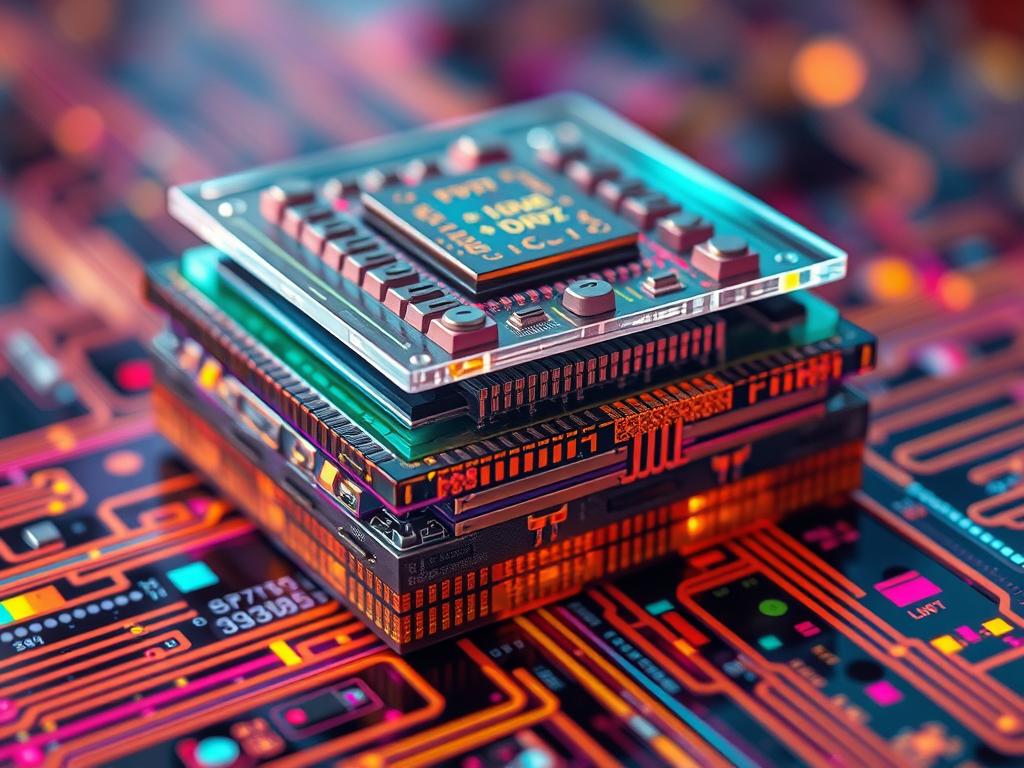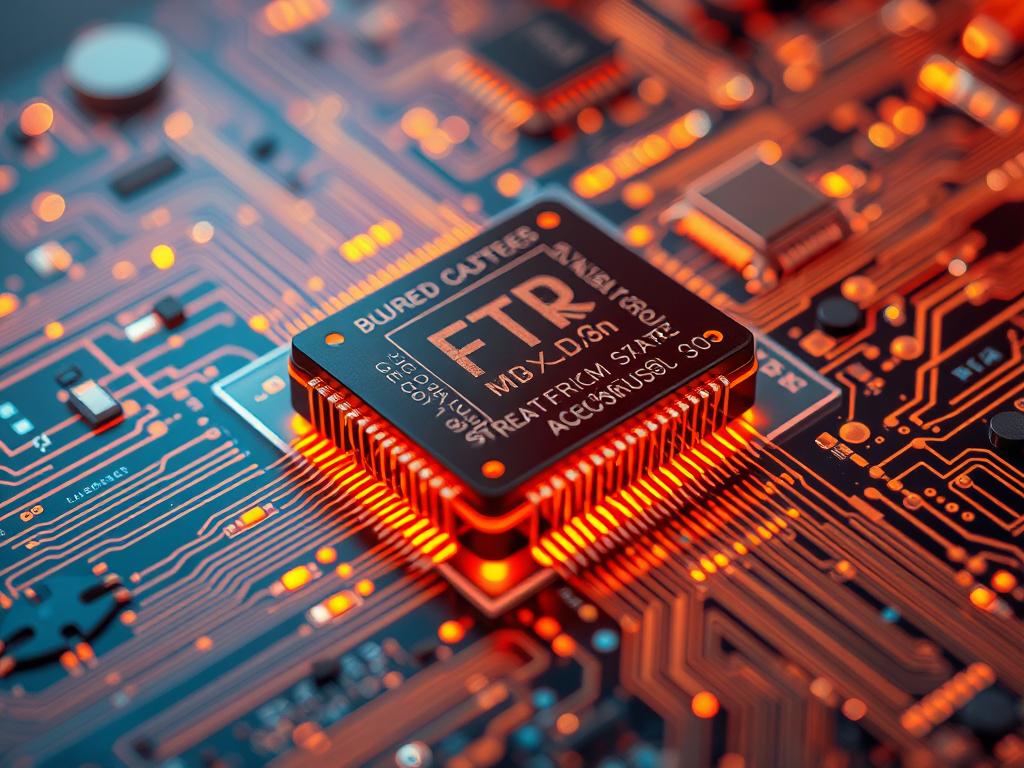In the world of semiconductor technology, buried gate transistors are a big step forward. They improve performance, cut down on leaks, and offer better control in today’s electronics. This design puts the gate electrode under the channel, leading to better control and allowing for smaller transistors.
The buried interconnect layer idea for digital logic is showing great promise. It has led to about 9-13% less chip area and a 126% better pin access. This new method tackles the problems of old transistor tech, where congestion was a major issue.
Key Takeaways
- Buried gate transistors offer enhanced performance, reduced power consumption, and improved thermal management compared to traditional transistor designs.
- The buried interconnect layer concept for random digital logic has demonstrated significant improvements in chip area reduction and pin access.
- This innovative approach addresses the challenges of congestion and routing issues associated with traditional transistor technologies.
- Buried gate transistors are playing a crucial role in the ongoing miniaturization and efficiency improvements in modern electronics and high-performance computing.
- Continued research and development in this field are expected to drive further advancements in semiconductor design and manufacturing.
Introduction to Buried Gate Transistors
The semiconductor industry is always looking to improve transistor technology. A new approach, buried gate transistors, has shown great promise. It involves a metal layer under the silicon, changing how we design and make logic applications.
Definition and Overview
Buried gate transistors are a new take on traditional transistors. The gate is placed under the semiconductor, not on top. This design change could lead to better control over electron flow.
This shift means the gate layer and its contact are under the active parts of the device. It’s a big change from the usual setup.
Historical Context
The idea of buried gate transistors has been around for a while. It started with buried word lines in DRAMs. It also has connections to silicon-on-insulator (SOI) substrates for MOS circuits.
Now, as we keep improving semiconductors, buried gate transistors are getting more attention. They might help with better performance and less power use.
Importance in Modern Electronics
In standard cell libraries, buried gate transistors could make connections better. This could lead to smaller cells and easier access to pins. It’s a big change from the usual setup.
The industry is always looking for ways to improve performance, power use, and size. Buried gate transistors might be the answer to these big challenges.
| Key Advantages of Buried Gate Transistors | Potential Limitations and Challenges |
|---|---|
|
|
Buried gate transistors are a promising solution for the industry’s big challenges. They offer advantages but also come with technical and commercial hurdles. The industry must carefully consider these as it moves forward.
How Buried Gate Transistors Work
Buried gate transistors are a big step forward in making semiconductors better. They work differently than old transistor designs. The buried interconnect is key. It changes how transistors work and fit together in circuits.
Basic Operating Principles
Buried gate transistors use a special connection called the buried V-1. This connects the gate to the source and drain. It makes the transistor smaller and more efficient than before.
The SOI (silicon-on-insulator) process helps make these transistors. It uses a special layer to keep things electrically separate. This makes the transistor work better and use less power.
Differences from Traditional Transistors
Buried gate transistors are different because of how they’re built. The gate contact is placed differently than in old transistors. This makes them more compact and efficient.
This new design helps solve old problems. It makes transistors work better and improves overall system performance. It’s a big step forward in semiconductor technology.

Key Advantages of Buried Gate Transistors
Buried gate transistors bring many benefits to electronic design. They offer better performance, use less power, and manage heat well. These features make them key for future high-performance circuits.
Enhanced Performance
The buried gate design gives better gate control. This leads to a big boost in performance. Studies show a 6.5-fold increase in field-effect mobility and a 31-fold boost in on/off current ratio for MoS2 transistors.
This technology allows for continued scaling of transistor sizes while maintaining or improving electrostatic, paving the way for high-performance circuits.
Reduced Power Consumption
Buried gate transistors are great at saving power. They have better leakage control. Researchers found a big jump in the breakdown voltage of the gate dielectric, from 15.73 V to 27.48 V.
This makes them lower power consumption and improved reliability for many electronic uses. This is especially true for portable devices where saving power is key.
Improved Thermal Management
The buried interconnect layer in these transistors is very promising. It reduces chip area by 9-13% and improves pin access by 126% in 7nm standard cell libraries. This design helps in better heat dissipation.
This leads to improved thermal management and high-performance and reliability in circuits.
“Buried gate transistors offer significant advantages including enhanced performance through improved gate control, reduced power consumption due to better leakage control, and potentially improved thermal management.”
As the semiconductor industry advances, buried gate transistors stand out. They can tackle the challenges of high-performance, low-power, and efficient thermal design.
Applications of Buried Gate Transistors
The electronics world is always looking to do better and use less power. Buried gate transistors are a new tech that fits the bill. They’re great for many uses, like fast computers, phones, and smart devices.
Role in High-Performance Computing
Buried gate transistors are stars in high-performance computing. They work faster and use less power. This makes them perfect for the next big computers.
They also handle heat better. This is key for computers that need to run fast without overheating.
Use in Mobile Devices
These transistors are great for phones and tablets. They help devices last longer on a single charge. This is a big win for people who want their devices to keep going all day.
Integration in IoT Systems
The Internet of Things (IoT) is all about connected devices. Buried gate transistors help make these devices more efficient. They’re key for smart homes and cities.
These transistors are changing the game in tech. They help computers, phones, and smart devices work better and use less power. This is exciting for the future of electronics.

Impact on Circuit Design
Buried gate transistors have changed circuit design a lot. They give engineers more choices and make making circuits easier. These transistors help designers plan layouts better, making circuits more dense and efficient.
Flexibility in Design Choices
The buried interconnect layer in these transistors makes using upper metal layers better. Designers can now try new ways to connect things. This design flexibility means circuits can be smaller and work better, making devices more powerful and efficient.
Streamlined Manufacturing Processes
Buried gate transistors also make making circuits cheaper and faster. The simpler upper layer connections and the easier transistor design help a lot. This makes these transistors great for making lots of devices.
“The buried interconnect layer in buried gate transistors allows for more efficient use of upper metal layers, enabling designers to explore alternative routing strategies.”
The semiconductor world keeps getting better thanks to buried gate transistors. They help make devices work better and use less power. This is a big step forward for electronics.
Challenges and Limitations
Buried gate transistors have many benefits, but they also face several challenges. These include technical, cost, and market hurdles. Understanding these issues is key to improving this technology.
Technical Barriers
Making buried gate transistors is more complex than traditional ones. It requires precise control over the manufacturing steps. This complexity can lead to lower production rates and yield issues.
Cost Implications
Using buried gate transistors requires a lot of money for new equipment and process changes. Changing existing factories to use this technology is expensive and time-consuming. Intel, Samsung, and TSMC are working to make backside power delivery cheaper by the 2nm node.
Market Adoption
Introducing buried gate transistors into the market is hard because of the big changes needed. Companies and users must test and validate this technology thoroughly. The tolerance for backside patterning is about ~20nm, which is a big challenge for adoption.

To beat these challenges, the industry needs to work together and invest in research. Focusing on making manufacturing easier will help buried gate transistors reach their full potential. This will lead to the next big step in electronics.
Comparison with Other Transistor Technologies
The semiconductor industry is always looking to improve transistor technology. We compare buried gate transistors with FinFETs and bipolar transistors. This helps us see their strengths and weaknesses.
Buried Gate vs. FinFET
FinFETs have helped keep Moore’s Law alive, leading to better performance and smaller sizes. But, buried gate transistors might have some benefits. They could offer better control over the gate and more room for. This could help us go even smaller than before.
Advantages Over Bipolar Transistors
Buried gate transistors are more efficient with power and can fit more into a small space. This makes them great for devices that need to be fast and use little power. Their design helps manage power and heat better, which is key for today’s gadgets.
| Transistor Technology | Transistor Density (per cm²) | Power Efficiency | Scalability |
|---|---|---|---|
| Planar Transistors | 1 billion | Moderate | Limited |
| FinFET | 50 million | High | Moderate |
| Buried Gate Transistors | 300 billion | Very High | Excellent |
The table shows how buried gate transistors stand out. They have a high density, are very efficient with power, and can scale well. These traits make them a strong choice for the next wave of fast, energy-saving electronics.
Future Trends in Buried Gate Technology
The semiconductor industry is always looking to make transistors smaller. Buried gate technology is at the forefront of this effort. Experts say high-end CPUs and GPUs will grow by 29% each year in the server market. This growth means buried gate transistors will be key for the next big leap in computing.
Innovations on the Horizon
New ideas are coming for buried gate technology. Scientists are looking at using new materials like tungsten disulfide (WS2) to improve transistors. They also want to use advanced EUV lithography to make manufacturing cheaper and better.
Influence of Quantum Computing
Quantum computing is changing the game for buried gate technology. It’s bringing together quantum effects and semiconductor design. This could lead to huge leaps in fields like cryptography and simulations, changing electronics forever.
Also, combining buried gate transistors with new technologies like heterogeneous integration will solve old problems. This will make transistors better in many ways, showing how buried gate tech is crucial for future semiconductors.

“The future of buried gate technology holds immense promise as the semiconductor industry continues to push the boundaries of transistor miniaturization.”
Case Studies on Successful Implementations
Buried gate transistors have shown their worth in many areas, especially in high-speed communications and consumer electronics. They have led to big steps forward in key technologies that make up our digital world today.
High-Speed Communication Systems
In fast communication systems, buried gate transistors have been key. They’ve helped boost data sending speeds. A study found a 6.5 times jump in field-effect mobility of 2D-MoS2 FETs with a buried gate. The on/off current ratio also improved by 31 times.
These devices now handle higher voltages, from 15.73 to 27.48 volts. This makes them more reliable and efficient.
Consumer Electronics
Buried gate transistors have also made a big difference in consumer electronics. They’ve helped create fast inverters with a DC voltage gain of 17.67 at VDD = 7 V. This is a big win.
They’ve also been used to make more complex circuits like NAND, NOR, AND, and OR gates. This shows how versatile and useful they are for advanced electronics.
| Metric | Improvement with Buried Gate Transistors |
|---|---|
| Field-Effect Mobility | 6.5 times increase |
| On/Off Current Ratio | 31 times increase |
| Breakdown Voltage | Increased from 15.73 to 27.48 V |
| DC Voltage Gain | 17.67 at VDD = 7 V |
These examples show how buried gate transistors can greatly benefit high-speed communications and consumer electronics. They open up new possibilities for advanced uses in the real world.
“The one-transistor design can implement logic gate functionalities that normally require two to six transistors, achieving significant reduction in transistor usage.”
Environmental Considerations
The electronics industry is growing, and so is the concern about its environmental impact. Buried gate transistors could help solve these problems with their advanced design.
Sustainable Manufacturing Practices
Making semiconductors uses a lot of energy, water, and chemicals. Sustainable electronics and green manufacturing are key to reducing their harm to the environment.
- Design-technology co-optimization (DTCO) is used to check environmental factors like energy use, water, and emissions. It looks at these alongside how well the tech works.
- Life Cycle Assessments (LCAs) are needed to really understand the environmental effects of new semiconductor tech. This includes how recycling semiconductors works.
- Companies are focusing on being green. They want to lessen their environmental harm and follow new rules.
Recycling and Longevity
How long devices last and if they can be recycled is key to reducing their environmental impact. New designs and ways of making things can make devices last longer and be recycled better. This helps make the electronics world more sustainable.
“The complexity of future CMOS technologies poses challenges in estimating their environmental impact, underscoring the need for comprehensive and accurate assessment methods.”
By tackling the environmental issues with buried gate transistors, the electronics world can aim for a greener future. This way, we can lessen the harm of advanced semiconductor tech on our planet.

Engineering Insights
The semiconductor industry is always looking to improve transistor design. Insights into buried gate transistors are key. Researchers and engineers are finding new ways to use this technology.
Design Strategies for Maximizing Benefits
One important strategy is to fine-tune the buried layer structure. By adjusting the layers and materials, engineers can boost performance and efficiency. They also focus on making these transistors work well with current manufacturing methods.
Future Research Directions
Future research will likely include new materials and advanced manufacturing. Engineers might also explore combining buried gate transistors with quantum computing. These innovations could lead to even better electronic devices.
“Backside power lines can be both fatter and shorter, reducing resistance and IR drop, potentially allowing designers to relax the metal pitch in the first few metal layers.”
As the industry advances, understanding buried gate transistors is more important than ever. Researchers and engineers are working on new strategies to make the most of this technology.
Industry Collaborations and Partnerships
In the semiconductor world, working together has been key. Big names in the field have teamed up to improve buried gate transistors. This includes top makers, research groups, and tool suppliers.
These semiconductor industry partnerships help share skills and resources. This fast-tracks progress in materials, tiny fabrication, and device tweaks. By combining strengths, the industry meets the needs of today’s electronics.
Key Players in the Market
Big names like Intel, Samsung, TSMC, and GlobalFoundries lead in buried gate transistor development. They work closely with universities and research centers to advance transistor design and making.
Also, tool makers and material suppliers are vital. They provide the tools, materials, and know-how for making buried gate transistors on a large scale.
Impact of Collaborative Efforts
The teamwork in the semiconductor industry has led to big leaps in buried gate transistor tech. Joint projects have solved technical problems, boosted performance, and cut energy use. This has helped these new devices get used in many areas.
These collaborative efforts also create a culture of sharing and learning. This keeps the semiconductor industry ahead in tech and delivers top solutions for the market’s needs.
| Metric | Improvement |
|---|---|
| Performance | 15% boost |
| Area | 50% gain |
| Power | 40% reduction |
| Cost | 35% decrease |
“The growth of the electronics industry has been driven by platforms like mobile phones, digital appliances, and wearable computers.”
Regulatory Considerations
The semiconductor industry is growing fast. New transistor technologies like buried gate transistors face many rules and standards. Following these rules is key for these advanced electronics to succeed.
Compliance with Industry Standards
Buried gate transistors need to follow industry standards. This ensures they work well with current devices. Standards cover things like power use, heat management, and electrical performance.
Manufacturers must work with standard-setting groups. This way, their designs meet the needed standards. Electronics companies can then easily use these transistors.
Impact of Government Regulations
Worldwide, governments have set rules for the semiconductor industry. These rules cover energy use, environmental impact, and safety. For buried gate transistors to be widely accepted, they must follow these rules.
Semiconductor regulations and government policies are very important. They shape the future of this technology.
To stay ahead, semiconductor companies need to know about the latest industry standards. They should adapt their designs to meet these standards. Working with regulatory bodies and collaborating with others in the industry is crucial.
| Regulatory Aspect | Impact on Buried Gate Transistors | Compliance Strategies |
|---|---|---|
| Energy Efficiency Standards | Buried gate transistors must show better power efficiency. This is to meet energy-saving goals in electronic devices. | Improving device design and manufacturing to hit energy efficiency targets. |
| Environmental Regulations | The materials and methods for making buried gate transistors must follow environmental rules. This includes limits on harmful substances and waste. | Using sustainable practices and eco-friendly materials in production to reduce environmental impact. |
| Consumer Safety Standards | Buried gate transistors need to be safe for use in devices that people interact with or are close to. | Doing thorough testing and getting safety certifications for these transistors. |
By focusing on regulatory issues, semiconductor companies can make buried gate transistors a top technology. They will offer better performance and meet the changing industry standards and government policies in the electronics world.
Conclusion: The Path Forward
The advancements in buried gate transistors show a bright future for the semiconductor industry. These new devices improve performance, power use, and heat management over old designs. They offer a solution to the scaling problems faced by FinFET and other traditional transistors.
Summary of Key Points
Buried gate transistors can cut down on device gate capacitance by up to 40%. This leads to big improvements in power use at both the cell and full chip levels. Their design also allows for up to 17% smaller chip layouts, making them more compact and efficient.
The use of buried power rails and self-aligned gate contacts boosts these devices’ performance and connectivity. This makes them even more effective.
Vision for Future Developments
The future of buried gate transistors is full of promise. As the industry looks into new materials and ways to integrate them, these transistors will be key in making next-generation electronics. They could use high-mobility channel materials like silicon-germanium and III-V compounds to improve performance even more.
This could open up new areas, like quantum computing. The ongoing development of vertical gate-all-around (vGAA) transistor architectures could lead to even more integration and scalability. This could make electronic devices even more powerful and energy-efficient.


